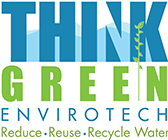Fiberglass Reinforced Plastics, FRP, is an excellent choice of material for the construction of Effluent Treatment Plants (ETP), Sewage/Grey water treatment plants (STP/GWTP), Water/Chemical storage tanks, piping systems, apparatus and other types of industrial process equipment. The FRP material properties beat many conventional materials, such as steel when it comes to chemical and corrosion resistance. Little maintenance and a long product life time, that is what well-engineered FRP equipment promise.
What is FRP
Basically, FRP material consists of thermosetting resins and fiberglass. The combination of resin and glass fibers, makes the main ingredient of FRP products. The resin brings the environmental and chemical resistance to the product and is the binder for the glass fiber in the structural laminate. Based on the chemical and environmental circumstances (given by the customer or user), a resin type is selected. In general, Thinkgreen constructs an FRP product with three laminates:
- Corrosion barrier: chemical resistance and temperature resistance
- Structural laminate: temperature resistance
- Topcoat: environmental and temperature resistance
Each type of laminate has its specific function, therefore for each laminate a different type of resin could be selected for making a product.
Furthermore, we have different types of glass to be selected, based again: on the application and processes the final product will be used for (different types of veils). With regard to composing these ingredients and choosing the right resins, latest technology and glass fiber components in order to guarantee the quality and the benefits of the materials, selecting the right manufacturer is highly important.
GRP or FRP?
In general, Thinkgreen refers to FRP, Fiberglass Reinforced Plastics, the most common used word for this composite material. However, many people use the term GRP, Glassfibre Reinforced Plastics, this is the same material, but the British English word. More and more, solely the word ‘fiberglass’ is applied when talking about FRP.
Characteristics of FRP
FRP is known for its mechanical strength and a popular choice when it comes to corrosion resistance. Furthermore is FRP light weight, has excellent temperature-resistant properties, offers thermal insulation and can be formed in complex shapes. FRP products are easy to repair and hardly require any maintenance.
The way Thinkgreen makes FRP products, FRP products are known for their smooth internal surface and seamless shapes, providing perfect flow of products.
Applicational areas of FRP
FRP products of Thinkgreen are used by domestic and industrial markets for Effluent treatment Plants, Sewage treatment plants, storage of fluids and many other customized applications Throughout the years, Thinkgreen has supplied industrial markets at regional, national and international levels; we developed our FRP products together with our customers and in accordance with the applicational requirements.
FRP Products
The majority of FRP products, such as ETPs, STPs, Storage tanks, duct systems, Piping systems, Chimney liners, etc are cylindrical in shape. Yet the benefit of working with FRP is the endless possibilities as regards thickness, capacity for combination with other materials, mix of materials, and is therefore lightweight, with smooth surfaces and possesses good insulation properties. FRP can also be used for non-cylindrical application such as pultruded profiles, non-cylindrical hand moulded applications and many other customized products.
FRP products are ideal for on-site installation. Our team of experts handle installation jobs for customers all over the world.
